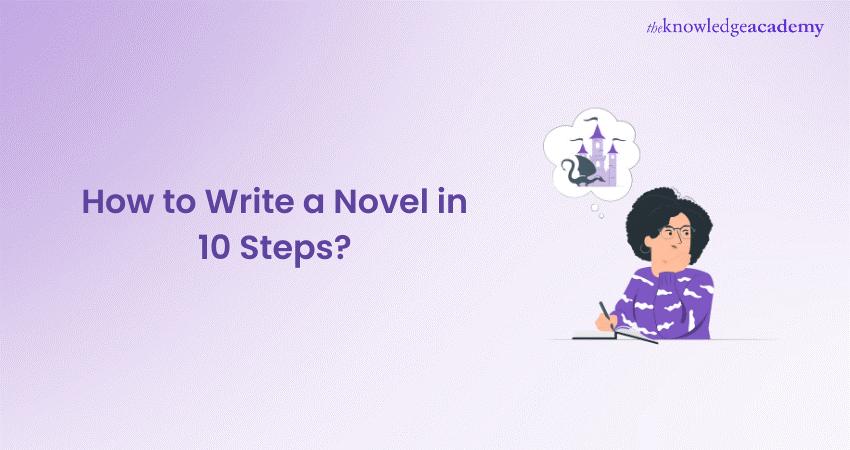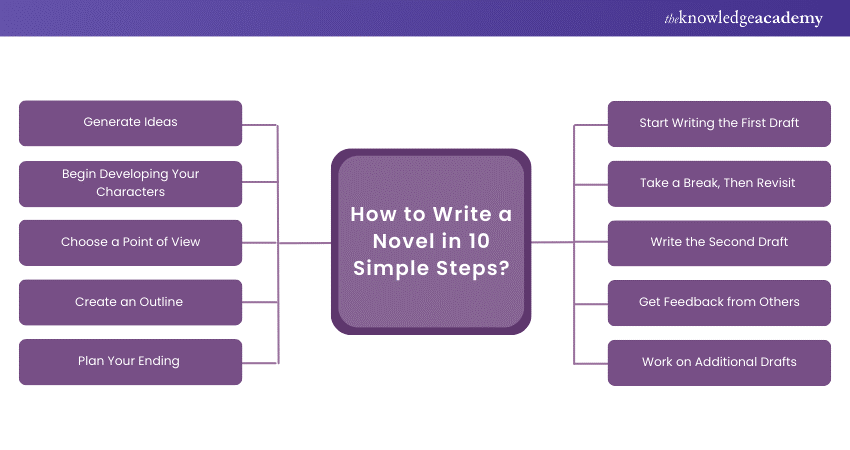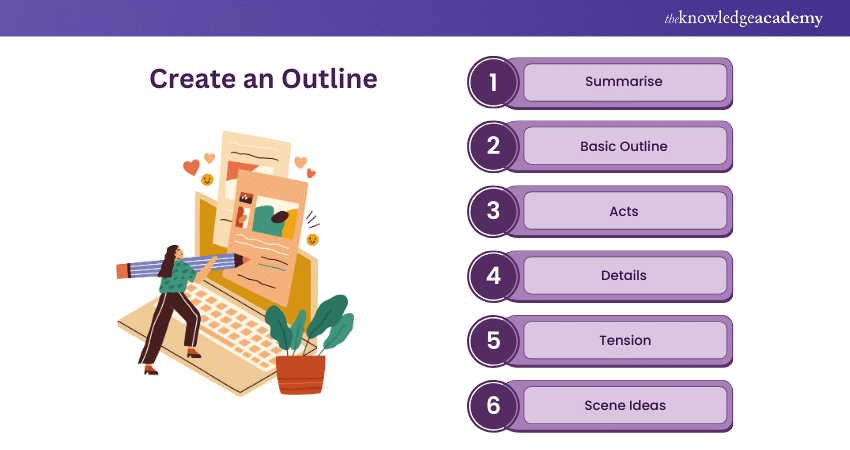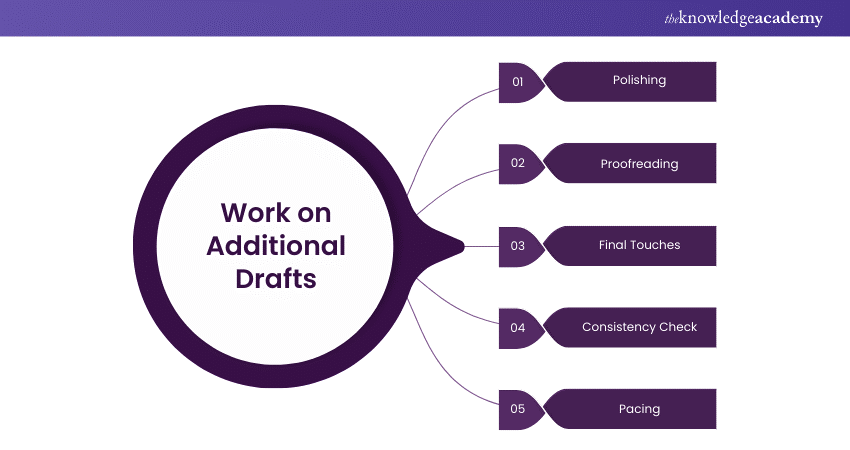We may not have the course you’re looking for. If you enquire or give us a call on +1800812339 and speak to our training experts, we may still be able to help with your training requirements.
Training Outcomes Within Your Budget!
We ensure quality, budget-alignment, and timely delivery by our expert instructors.

Imagine sitting in your favourite cosy spot, daydreaming about the characters and worlds you could create. Have you ever wondered how to turn those daydreams into a novel that captivates readers? You’re not alone! Every great storyteller began with a spark of inspiration. This blog on How to Write a Novel is your guide, lighting the way from your initial idea to a polished manuscript.
Starting a novel might seem overwhelming but breaking it down into smaller tasks makes it manageable and fun. Each section of this blog on How to Write a Novel provides the tools and confidence you need to bring your unique story to life. So, grab your pen, unleash your imagination, and let’s embark on this exciting adventure together!
Table of Contents
1) What is a Novel?
2) How to Write a Novel in 10 Simple Steps?
a) Generate Ideas
b) Begin Developing Your Characters
c) Choose a Point of View
d) Create an Outline
e) Plan Your Ending
f) Start Writing the First Draft
g) Take a Break, Then Revisit
3) Conclusion
What is a Novel?
A novel is a captivating work of fiction that dives deep into intricate topics, characters, and storylines, usually presented in prose. Novels come in all shapes and sizes, from literary fiction to genres like romance, mystery, or science fiction. Each book opens the door to a world crafted by the author, inviting readers to experience emotions, face conflicts, and discover resolutions.
Typically, novels range from 40,000 to 100,000 words, though this can vary. Their length allows for rich, intricate narratives and profound insights into characters, themes, and settings. Novels cater to all age groups and span various categories. Some novels blend multiple genres or defy categorisation altogether, making each reading experience unique and exciting.
How to Write a Novel in 10 Simple Steps?
Writing a novel can seem daunting but breaking it down into manageable steps makes the process both exciting and achievable. Whether you’re a seasoned writer or a beginner, these 10 simple steps will guide you from your initial idea to a polished manuscript, helping you bring your unique story to life.

1) Generate Ideas
Novels are more than just a series of locations and eras; they need a compelling narrative that keeps readers engaged from start to finish. Identify the story you want to tell and ensure it can sustain an entire novel. If your story feels too short, consider turning it into a short story instead.
a) Brainstorm: Jot down any ideas that come to mind, no matter how wild.
b) Research: Look into topics that interest you to spark new ideas.
Inspiration: Draw from personal experiences, news stories, or even dreams.
2) Begin Developing Your Characters
A great idea alone won’t make your novel succeed; you need characters that readers can connect with. Once you’ve established your world and narrative, identify the key characters. The protagonist is crucial—know their background, traits, and significant life events. The better you understand your characters, the more vividly you can portray them.
a) Character Profiles: Create detailed profiles for each main character.
b) Backstories: Develop rich backstories to give depth to your characters.
c) Motivations: Understand what drives each character and how it influences their actions.
3) Choose a Point of View
Understanding your characters helps determine your narrative voice. Will you write from a personal perspective or an external one? Here are common narrative voices:
a) First Person: A character narrates using “I,” offering a personal view that can heighten emotional tension.
b) Second Person: Uses “you,” which is rare but can be impactful for certain moments.
c) Third Person: A more detached perspective, either omniscient or limited, focusing on objective information or following the protagonist’s thoughts.
d) Experiment: Try writing a few scenes from different perspectives to see which feels right.
Speed up your writing skills with our Speed Writing Course - register now!
4) Create an Outline
A well-structured outline is essential for a compelling story. Here are some tips:

a) Summarise: Condense your story into one sentence.
b) Basic Outline: Develop a basic outline with the main storyline.
c) Acts: Divide the narrative into acts.
d) Details: Add specifics to each scene.
e) Tension: Include moments of tension to keep readers engaged.
f) Scene Ideas: Note down scene ideas even if you don’t have a specific place for them yet.
5) Plan Your Ending
If you haven’t already, decide on a captivating conclusion. The ending is often the most memorable part for readers, so make it impactful. A clear ending helps shape your narrative and character development.
a) Reader’s Perspective: Consider how you want readers to feel at the end.
b) Resolution: Ensure all major plot points are resolved.
c) Foreshadowing: Use foreshadowing to build up to your ending.
6) Start Writing the First Draft
Planning is important, but don’t let it stop you from writing. Your first draft might be rough, but it’s crucial to start. It’s okay if it’s long and messy—you’ll have time to revise.
a) Set Goals: Set daily or weekly writing goals to keep yourself on track.
b) Stay Flexible: Allow your story to evolve as you write.
c) Ignore Perfection: Focus on getting words on the page rather than making them perfect.
7) Take a Break, Then Revisit
After finishing your first draft, take a break. Returning with fresh eyes will help you see your work differently. Focus on clarity, character development, world-building, and timing when revising.
a) Rest: Take a few days or weeks off from your manuscript.
b) Fresh Perspective: Read your draft as if you were a new reader.
c) Notes: Make notes on areas that need improvement.
Stay motivated and reach your goal faster with our Motivation And Goal Setting Training - sign up now!
8) Write the Second Draft
Based on your evaluation, make precise changes or major revisions. If necessary, consider a “page one rewrite” to reshape the novel from scratch.
a) Targeted Revisions: Focus on specific scenes or chapters that need work.
b) Big Picture: Ensure the overall story arc is strong.
c) Consistency: Check for consistency in character behaviour and plot details.
9) Get Feedback from Others
Share your second draft with trusted readers for feedback. Pay attention to recurring issues pointed out by multiple readers. Distinguish between identifying problems and suggesting solutions—use feedback to enhance your vision.
a) Beta Readers: Choose a few people whose opinions you trust.
b) Constructive Criticism: Be open to feedback but stay true to your vision.
c) Multiple Opinions: Compare feedback from different readers to identify common issues.
10. Work on Additional Drafts
There’s no set number of drafts for a successful novel. Some may need only a few drafts with light editing, while others require multiple revisions. Expect unique challenges and victories with each novel you write.

a) Polishing: Focus on refining your prose and tightening your narrative.
b) Proofreading: Check for grammar, spelling, and punctuation errors.
c) Final Touches: Add any final touches to make your story shine.
d) Consistency Check: Ensure consistency in character development, plot progression, and world-building details throughout your novel.
e) Pacing: Review the pacing of your story to ensure it maintains reader interest and flows smoothly from beginning to end.
Conclusion
As you reach the end of this blog on How to Write a Novel, remember that every great novel starts with a single idea and the courage to bring it to life. Writing a novel is a journey filled with creativity, challenges, and immense satisfaction. By breaking down the process into manageable steps, you can transform your daydreams into captivating stories that resonate with readers.
Craft new stories and inspire minds with our Creative Writing Course - Sign up now!
Frequently Asked Questions

A novel aims to entertain, inform, and provoke thought by telling a story. It explores human experiences, emotions, and societal issues, allowing readers to connect with characters and situations. This often leads to personal reflection and a deeper understanding of the world.

Novels typically follow a structure that includes an introduction, rising action, climax, falling action, and resolution. This structure helps to build tension, develop characters, and advance the plot, ensuring a coherent and engaging narrative.

The Knowledge Academy takes global learning to new heights, offering over 30,000 online courses across 490+ locations in 220 countries. This expansive reach ensures accessibility and convenience for learners worldwide.
Alongside our diverse Online Course Catalogue, encompassing 19 major categories, we go the extra mile by providing a plethora of free educational Online Resources like News updates, Blogs, videos, webinars, and interview questions. Tailoring learning experiences further, professionals can maximise value with customisable Course Bundles of TKA.

The Knowledge Academy’s Knowledge Pass, a prepaid voucher, adds another layer of flexibility, allowing course bookings over a 12-month period. Join us on a journey where education knows no bounds.

The Knowledge Academy offers various Personal Development Courses, including the Creative Writing Course and Practitioner Course, and the Speed Writing Course. These courses cater to different skill levels, providing comprehensive insights into Blended Learning.
Our Business Skills Blogs cover a range of topics related to Personal Development, offering valuable resources, best practices, and industry insights. Whether you are a beginner or looking to advance your Creative Writing skills, The Knowledge Academy's diverse courses and informative blogs have got you covered.
Upcoming Business Skills Resources Batches & Dates
Date
 Creative Writing Course
Creative Writing Course
Fri 6th Dec 2024
Fri 10th Jan 2025
Fri 28th Feb 2025
Fri 4th Apr 2025
Fri 16th May 2025
Fri 11th Jul 2025
Fri 19th Sep 2025
Fri 21st Nov 2025
 Halloween sale! Upto 40% off - Grab now
Halloween sale! Upto 40% off - Grab now







 Top Rated Course
Top Rated Course



 If you wish to make any changes to your course, please
If you wish to make any changes to your course, please


